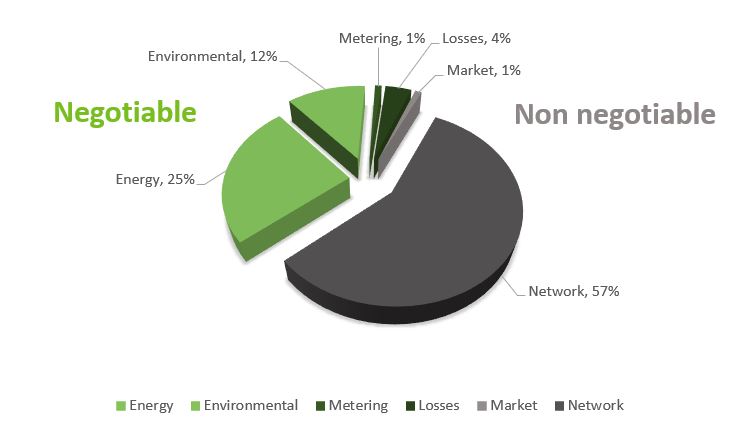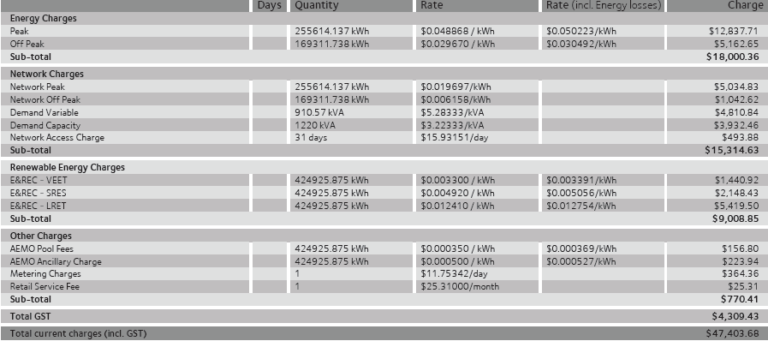Your electricity bills are made up of many components and many factors affect these charges.
As an energy user, the portion of these invoices that is within your control is the Energy Charges component of the bill, by working with an energy consultant to negotiate a competitive rate for the contracted period.

Source: AG Innovators 2014
STILL NEED HELP?
Your Energy Charges are the costs of raw electricity (kW) which the retailers purchase from the wholesale market and sell to you as the end user. The rates that you can secure are dictated by a wholesale commodity market which is driven by factors such as base generation, government policy, seasonal demand, and competition.
This section of the bill is one of the largest components of the overall bill and is the only major controllable cost in which your retailer is solely responsible.
The main components of this section:
These are the units of the cost charged by your supplier for varying periods throughout the day. Below is an example of a typical bill for a large energy user:

Electricity users who consume in excess of 160,000 kWh/pa ($40,000 approximately), and are on an unbundled agreement, will find a section labeled “Network Charges” on their bill.
The Network Charges cover the costs to maintain the grid infrastructure and the transport of the electricity from electricity generators across the electricity transmission and distribution networks to your site.
Network Charges generally account for 50 percent of a typical bill. They are reviewed on an annual basis and adjusted to reflect the costs of maintaining and upgrading the system.
The Australian Energy Regulator (AER) oversees networks and monitors compliance within the National Electricity Laws and Rules.
Network charges are reviewed annually.
From the 1st July 2021 electricity users in New South Wales, Victoria, Queensland, South Australia, ACT and Tasmania experience a change in their network charges.
Network charges are billed under various regulated tariffs published by the networks. The charges will typically relate to:
Network costs vary from tariff to tariff for each of the network providers. Your new network costs will be determined by applying your site-specific consumption and demand to the newly approved regulated tariff assigned to your site.
The final details of the increases will be published by each individual network operator a couple of weeks before they become effective.
Environmental Charges are costs associated with complying with Government schemes which are aimed at promoting efficient use of energy, reducing greenhouse gas and funding renewable energy generation.
There are currently six schemes which apply to large businesses:
Both the LRET and SRES schemes are linked to the Federal Government’s targets of 20% of energy generation from renewable sources by 2020.
The other schemes are state-based schemes and are regulated by the state governments.
The regulator estimates how many certificates will need to be surrendered for that year to meet the targets.
Based on this estimate, the regulator determines a compliance percentage of the applicable certificates that the liable entity (your retailer) will need to purchase and surrender on behalf of their customers.
Market Charges are fees which are paid to the Australian Energy Market Operator (AEMO) to operate and maintain the National Electricity Market (NEM).
There are two costs which are categorised under Market Charges:
Depending on which electricity retailer and metering services you use, you may find some other charges on your electricity bill.
These charges are set by either your electricity retailer or meter provider and hence actual charges on your bill may vary in quantity and price.
As electricity flows through the transmission and distribution networks, energy is lost due to heating of conductors, this is caused by electrical resistance.
These losses are equivalent to around 10 percent of the total electricity transported between power stations and market customers.
Energy losses on the network must be factored in at all stages of electricity production and transport to ensure the delivery of adequate supply to meet prevailing demand and maintain the balance of the power system.
This means that more electricity must be generated than is required by consumers to allow for this loss during transportation.
The impact of network losses on retail prices is mathematically represented as Transmission Loss Factors (TLF) and Distribution Loss Factors (DLF).
Loss factors are calculated and fixed annually.
Site-specific loss factors are determined by location, connection type and level of voltage.
How are they shown on your bill?
All energy retailers must include loss factors as part of their electricity bills but the way in which they are represented can change depending on the billing structure of your retailer.